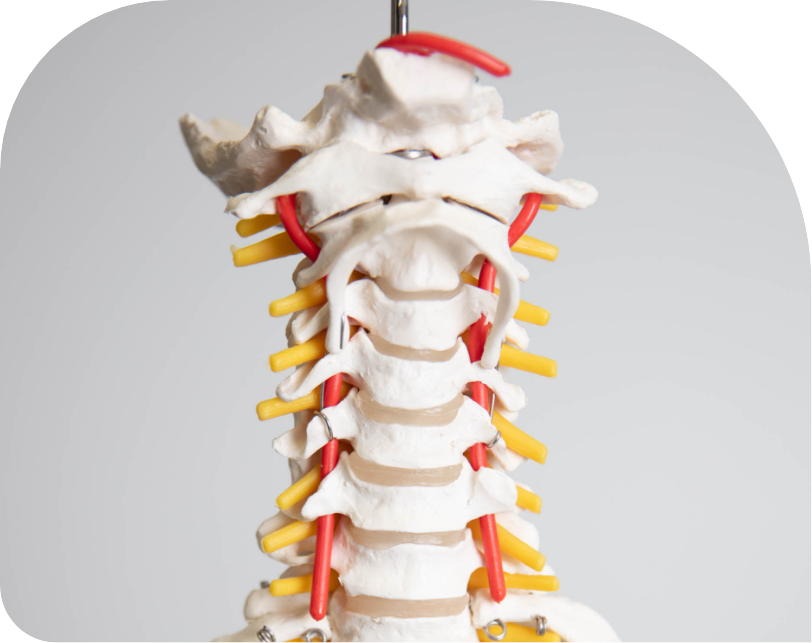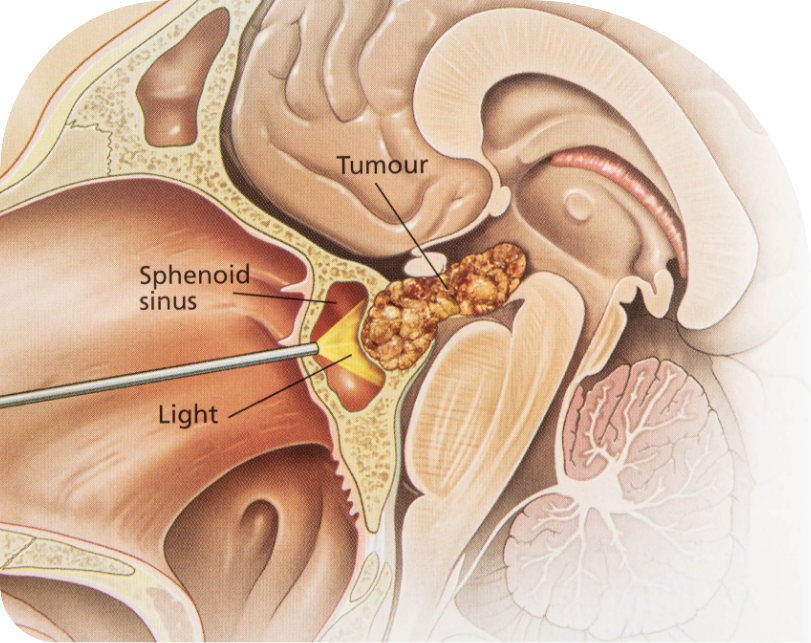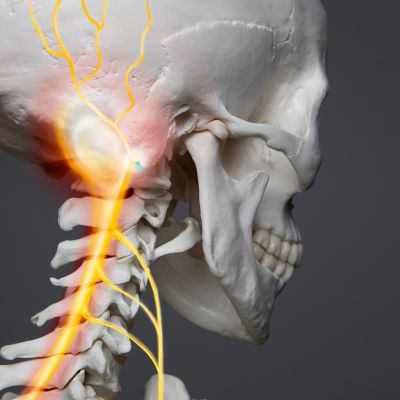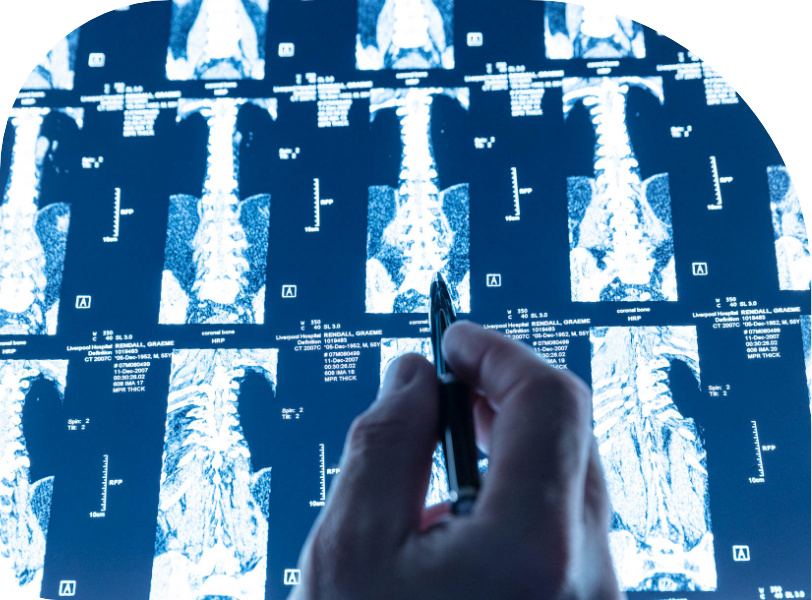tumours

Learning you have a brain, spinal or peripheral nerve tumour can be alarming and overwhelming. Early diagnosis, compassionate support and a personalised, multidisciplinary treatment plan can help you navigate this journey and optimise your quality of life.
Tumour TYPES
Tumours may arise in the brain, spine, pituitary gland or peripheral nerves. Some are benign, others are malignant (cancerous).

Brain tumours
Primary brain tumours arise from brain tissue or surrounding membranes. They include:
- Gliomas: a group including astrocytoma, oligodendroglioma and glioblastoma, that arises from neuron supporting cells of the brain
- Meningiomas: typically benign tumours arising from the protective tissue layers surrounding the brain known as the meninges
- Metastatic brain tumours: cancerous tumours that begin in the breast, lung, skin (melanoma) and spread to the brain.
- Primary central nervous system lymphoma: this special type of blood cancer involves primarily the brain

Spinal tumours
Spinal tumours may compress the spinal cord or nerve roots. They include:
- Metastatic tumours: these cancers begin in the breast, lung, prostate or kidney and spread to the vertebrae.
- Benign tumours: such as meningioma, schwannoma and neurofibroma arising from the tissue layers surrounding nerves
- Primary cord tumours: these arise within the spinal cord from neuron supporting cells, such as ependymoma and astrocytoma
- Haematological tumours: including multiple myeloma lesions in vertebrae

Pituitary tumour
The pituitary gland produces and releases important hormones.
When a tumour develops in the pituitary gland, it can affect hormone balance, causing troubling symptoms.
Reassuringly, most pituitary gland tumours are adenomas (benign growths), which won’t spread to other parts of your body, though treatment may still be necessary.

Peripheral nerve tumour
Peripheral nerve tumours are abnormal growths that develop in or near the nerves that connect the brain and spinal cord to the rest of the body.
Most of these tumours are benign (non-cancerous), but some can be malignant and aggressive. The most common types are schwannomas and neurofibromas.
Procedures
The most appropriate treatment for a tumour depends on factors such as its type, size, location and likely health impacts. Your treatment team may recommend watchful waiting, conservative treatments, chemotherapy, radiotherapy or one of the surgical procedures below.
empty
A craniotomy involves creating an opening in the skull to access and remove intracranial tumours. It remains the gold-standard approach for many brain neoplasms, offering direct visualisation and maximal safe resection.
In some cases this procedure is performed with the patient fully awake to enable real time monitoring of motor and speech functioning at surgery, so that safe tumour resection can be maximized.
This minimally invasive procedure uses 3D imaging to guide a needle into the tumour for tissue sampling. This helps to establish a definitive diagnosis before planning further treatment.
Often used for pituitary tumours, this technique involves inserting a small camera and surgical instruments through your nasal passages (or a keyhole opening). It allows tumour removal with reduced disruption to surrounding tissues.
For spinal tumours, a laminectomy (removal of part of the vertebral bone) creates space to access and remove lesions, relieving pressure on the spinal cord and nerve roots.
In some cases, after removal of tumours from the vertebrae, reconstruction using rods, screws and cages is required to protect the spinal cord and restore spinal stability. 3-D printed implants may also be required for better anatomical fit and healing.
Using high-powered microscopes tumours are delicately removed while minimizing damage to healthy nerve fibres. Surgeons aim to protect or repair nerve fascicles to maintain motor and sensory function. Electrical nerve stimulation is employed to help guide safe dissection and assess nerve integrity during surgery.

Risks and considerations
Any surgical or invasive procedure involves risks. When treating brain, spine or pituitary tumours, the potential risks include:
- Bleeding or haematoma formation, which may require further intervention
- Infection, mitigated through sterile technique and careful monitoring
- Neurological changes such as weakness, sensory disturbances or speech difficulties
- Cerebrospinal fluid leak, which may necessitate additional treatment
- Pain and swelling, managed with personalised pain relief and rehabilitation support.
Risks and considerations
Any surgical or invasive procedure involves risks. When treating brain, spine or pituitary tumours, the potential risks include:
- Bleeding or haematoma formation, which may require further intervention
- Infection, mitigated through sterile technique and careful monitoring
- Neurological changes such as weakness, sensory disturbances or speech difficulties
- Cerebrospinal fluid leak, which may necessitate additional treatment
- Pain and swelling, managed with personalised pain relief and rehabilitation support.

Why choose Macquarie Neurosurgery and Spine?
We’re one of the largest academic neurosurgery groups in Australia and have gained international recognition for our expertise in treating brain tumours.
Our patients benefit from our:
- Multidisciplinary expertise
- State-of-the-art techniques
- Patient-centred approach.
We’re here to help you navigate your tumour diagnosis, providing clear explanations, evidence-based care and empathetic support throughout your journey.

Disclaimer
All information is general and not intended as a substitute for professional advice. Any surgical or invasive procedure carries risks.
